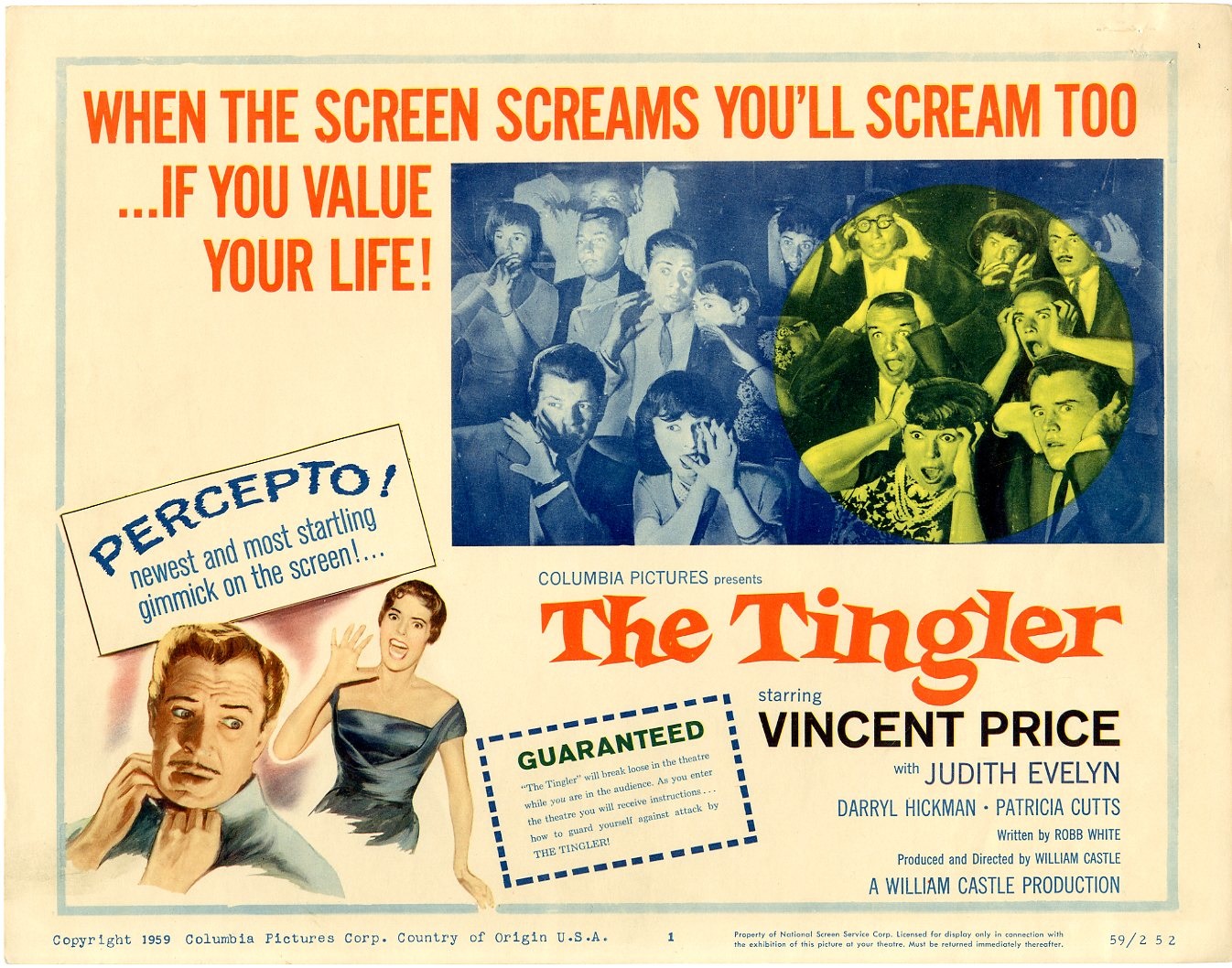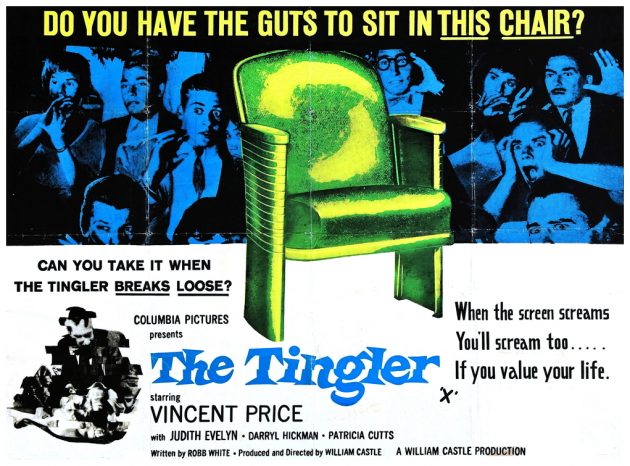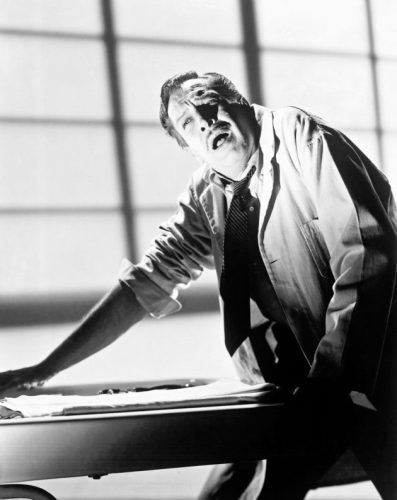

Following the success of House on Haunted Hill in February 1959, maverick US producer/director William Castle engaged Vincent Price once for a second time in The Tingler.
Price plays pathologist/scientist Warren Chapin, who is researching the psychological and physical causes and effects of fear. While brainstorming with his assistant David (Darryl Hickman), he discovers that fear manifests itself as a parasitic creature, which grows on human spinal cords. If a patient screams, it can be destroyed. If they don’t, it will sever the spinal column and kill them…
Chapin gets an opportunity to obtain a living specimen when Ollie Higgins (Philip Coolidge), the brother-in-law of a recently-executed murderer, stages the death of his deaf-mute wife Martha (Judith Evelyn). Once captured, the centipede-like creature escapes and runs amok in the Higgins’ movie theater. Terror is loose, and only your screams can stop it!
Here are some few fun facts about William Castle’s gimmick-laden masterpiece…

The story was inspired by a prop rubber worm
The Tingler was conceived during the production of House on Haunted Hill when Castle and screenwriter Robb White viewed a rubber worm made by makeup man Jack Dusick (the father of Knot’s Landing star Michele Lee, and grandfather of actor David Farentino and former Maroon 5 drummer, Ryan Dusick).
Castle and White then came up with a story, which they originally called The Chiller, that dealt with the essence of fear, drawing on an ancient Egyptian belief that the spirit resided within the spine and that vengeful entities could be released by trepanning (drilling a hole in the back of the head). The film’s ‘monster’ was also drawn from White’s memory of a giant millipede that he saw while living in the Virgin British Islands. The creature’s final look is a large-scale version of an Onychophora (commonly known as a velvet worm).

It was shot in just 12 days and released two months later…
Budgeted at US$400,000, the film was shot between 18 May 1959 to 1 June 1959, and went on general release in the US on 29 July to great success, helped, no doubt, by a huge publicity campaign (which brought its costs to around US$1million) and by Castle attending all the openings and even interviewing cinema patrons. The Tingler escaped into UK cinemas in October of the same year.

It broke the Fourth Wall…
Inspired by Alfred Hitchcock’s cameos in his own movies and TV show, and in a nod to Universal’s Frankenstein (1931), Castle (1914-1977) opens the film with an on-screen warning. This was first time he appeared to talk directly to an audience, but it soon became something of a trademark. Vincent Price also breaks the fourth wall during the film’s climax!

It has not one – but three gimmicks!
‘I’m going to buzz the asses of everyone in America,’ declared Castle, who came up with the ingenuous idea of attaching army surplus vibrators underneath selected cinema seats. These had been aircraft wing defrosters, which shook ice free in bad weather, and their effect became his most famous gimmick, ‘Percepto!’.
During the film’s climax, when the Tingler gets loose during a screening of the 1921 silent film, Tol’able David, the projectionist threw a switch and the motors starting buzzing – which caused audiences to jump and scream. Castle then employed a second gimmick: sudden stereophonic sound. Turning off the lights (and the film), Price is heard over a loudspeaker crying out: ‘Ladies and Gentlemen, the Tingler is loose in the theatre! Scream for your lives!’ and then announces that a patron has fainted. And when the lights went up in the theatre, a real live ‘victim’ would be carried out on a stretcher. When The Tingler headed to US drive-ins, Castle recorded an alternative warning substituting his voice for Price’s.
At one cinema, where The Nun’s Story was screening during the day, and The Tingler after-hours, the projectionist accidentally switched on Percepto! during a poignant moment in the film, causing a bit of a ruckus.

Percepto! was Castle’s third gimmick idea.
In 1958’s Macabre, Castle offered a $1000 life insurance policy against ‘Death by Fright’, then in 1959’s House on Haunted Hill he had a skeleton fly over cinemagoers, which he coined ‘Emergo’. The gimmicks kept coming in Castle’s subsequent films, including a handheld ghost viewer/remover in 13 Ghosts (1960), a fright break in Homicidal (1961), a punishment poll in Mr Sardonicus (1961), a glow-in-the-dark coin for Zotz (1962), and seats with belts in I Saw What You Did (1965). Percepto!, however, remains his most ingenious idea and has been referenced in two Joe Dante films Gremins 2 (1990) and Matinee (1993).

Castle’s Blood Bath!
While The Tingler was shot in black and white, Castle gives audiences one scene in colour. Having been driven into her bathroom after some hokey scares conjured up by her masked husband, poor deaf, mute Martha faces her greatest fear – blood. The sink is filling up with it, and the bathtub is full to the brim. If that’s not scary enough, a hand reaches out towards her. And when she sees her own death certificate (which states her birth place as Red Bank, New Jersey – obviously an in-joke about blood), Martha dies of fright.
To achieve this, it is said that a set was built in shades of black and white so that it would photograph on colour film as if were being shot on mono stock. For the black and white release prints, however, the colour footage had to be manually spliced in. Whether this is true or not is by the by as it’s one of Castle’s greatest visual tricks of his entire career.

The Tingler cemented Price’s reputation as a horror star…
While Price showed his natural flair for playing villains, cads and tortured souls besieged by fate in films like Dragonwyck, House of Wax and House on Haunted Hill, it was The Tingler that earned him the moniker, the Master of Menace. And when he followed this with House of Usher the following year, he would finally become the new King of Horror.

The silent film era is honoured…
While set in modern-day 1950s America, the film pays homage to the silent film era and the decline of the US movie theatre industry by staging some of the action in an old movie theatre, which screens silent movies. Broadway star Evelyn, effectively uses expressionistic mannerisms to convey the phobic mute Martha as a silent film character – and there’s one scene that recalls FW Murnau’s Nosferatu. When Martha has her fainting spell, she clutches at her nightgown in a similar manner to Max Shreck’s vampire Count Orlok when the morning rays reduce him to a puff of smoke in the closing moments of the 1922 silent classic. Castle also employs stage tricks and silent movie situations during Martha’s big scare scene, including a panel door sliding open to reveal a hairy simian hand brandishing an axe.

It was the first LSD trip seen on film…
In order to experience true fright, Chapin takes a hit of LSD, which was still legal in the US (and remained so until 1971). Screenwriter White drew on own experience of trying it as a student, but he felt Price went OTT with his performance. But he did his best, and provides the film with one of its most effective scenes that’s become justly famous, mainly for his cries of ‘the walls!’ as he imagines them closing in on him and of a skeleton seemingly coming alive (echoing the Emergo gimmick from House on Haunted Hill). Interestingly, the title of the book that Chaplin reads, Fright Effects Induced by Injection of Lysergic Acid LSD25, is printed on the back cover. Was it to get a better shot or a goof?

It borrows from the best…
Castle drew on Dr X, Mystery of the Wax Museum and even House of Wax for the scene in which Martha’s corpse inexplicably rises up from under a white sheet, while her bathroom death is a direct lift on the film that got Castle into movies in the first place; Les Diaboliques (1954).
Robb White also gives The Fly (1958) a nod when Chapin quips: ‘I felt as though my arm were in one of those hydraulic presses’, while the Chapins trading insults echo the warring Lorens in House on Haunted Hill. The Blob is also riffed when the Tingler gets loose in the movie theatre.

Screenwriter Robb White loved adventure stories…
White turned out five screenplays for Castle, but was also a prolific writer of maritime-set adventure stories aimed at young readers. His 1953 memoir, Our Virgin Island, about his and his first-wife Rodie’s exploits sailing the Atlantic landed him a spot on This Is Your Life in 1958.
Several of White’s 24 novels ended up on the school-based Scholastic book-sale program, including 1972’s Deathwatch, which was awarded the 1973 Edgar Award for Best Juvenile Mystery from the Mystery Writers of America. White died in 1990 (aged 81) as a result of head injuries suffered in a car accident.

The real life movie theatre also has a killer history
The Higgins movie theatre was inspired by the Silent Movie Theatre (at 611 North Fairfax Ave) in Los Angeles. Founded in 1942 by Dorothy and John Edward Hampton, it began attracting younger audiences in the late 1950s who were seeking out the films of Charlie Chaplin, Mary Pickford and Buster Keaton. Following Hampton’s retirement in 1980, the theatre was closed down.
In 1992, it was purchased and reopened by Laurence Austin, but in a scenario that could have come out of a big screen thriller, Austin was gunned down in 1997 by a hitman hired by his projectionist. A 19-year-old employee was also shot, but survived the attack. Today, the theatre is owned by Cinefamily, who continue to screen silents once a week.

Judith Evelyn and Philip Coolidge were big Broadway stars
Stage, screen and radio actress Judith Evelyn (1909-1967) had previously worked with Price on Broadway in the hugely success psychological thriller, Angel Street (aka Gas Light), written by Patrick Hamilton, which ran for 1295 performances from 5 December 1941 to 30 December 1944. And it was Price who suggested Evelyn for the role of Martha.
Philip Coolidge (1908-1967), also had an extensive career on Broadway appearing in major roles in productions like The Crucible. At the time filming, Coolidge had just finished appearing in the Gore Vidal’s A Visit to a Small Planet at the Booth Theatre in New York.

Darryl Hickman and Pamela Lincoln were a real life couple…
27-year-old Hickman was a former child actor who was brought to the film because Castle was seeking out a teenage audience. The fact that he was dating Lincoln, who plays his girlfriend Lucy, was an added bonus. In fact, Hickman took no payment for his role, as Castle convinced him that the film would help raise Lincoln’s profile as an actress. The couple married in November 1959 and, after raising two sons, divorced in 1982.
Hickman and Price had previously appeared in 1946’s Leave Her to Heaven (although not together) and For his scenes opposite Price, Hickman had to wear lifts as Vincent was six inches taller than him.

There’s a Coronation Street connection…
Patricia Cutts, who plays ever-so brilliantly Price’s bitchy femme fatale wife Isabel, was a British-born actress (and daughter of esteemed Gainsborough Pictures film director Graham Cutts) who later moved back to the UK after the offers dried up.
In August 1974, she landed a plum role on Coronation Street playing Dierdre Barlow’s mother Blanche Hunt. Cutts appeared in only two episodes when her body was found at her flat in Elm Park Gardens, Chelsea. According to the coroner, the 48-year-old actress had taken up to 30 time the normal dose of barbiturate tablets. Maggie Jones stepped into the role of Blanche, which she played for 830 episodes until her own death (aged 75) in December 2009.

Look out for…
Dal McKennon (1919-2009), who plays the the projectionist. He had a successful career as the voice of many screen and TV characters, including Buzz Buzzard in the Woody Woodpecker cartoons, Archie and Gumby, and a host of Disney films. He also played innkeeper Cincinnatus in TV’s Daniel Boone.

It’s a body horror classic…
A parasitic creature attached to the human spine that feeds on our fears maybe a wildly absurd concept, but this violation of the human body is a key theme of the body horror genre, which has its roots in early Gothic literature like Mary Shelley’s Frankenstein as well as 1950s sci-fi classics like Invasion of the Body Snatchers and The Fly, and certainly reached heady excess in the 1970s and 1980s. Today, The Tingler may elicit more laughs than screams, but this wormy lobster-like creature on a string deserves its place beside some other body horror fare like David Cronenberg’s Shivers and John Carpenter’s The Thing.

Home Entertainment Releases
Columbia Pictures released the film on DVD for its 40th anniversary in 1999, that was later included on the William Castle Film Collection DVD set, in 2009. This digitally remastered release included the Scream For Your Lives! 1999 documentary (16 mins) featuring actor Darryl Hickman, archivist Bob Burns and film historian David Skal; William Castle’s Drive-In “Scream!” Scene; the original ‘Scream’ Scene; theatrical trailer and Talent Files.
In August 2018, Scream Factory released the film on Blu-ray in its original aspect ratio of 1.85:1, which included an audio commentary by author Steve Haberman, interviews with actress Pamela Lincoln and publicist Barry Lorie, and the original 1959 Theatre Lobby Spot featuring a tune that apes The Blob theme. Carried over from the DVD release was the Scream For Your Lives! featurette, William Castle’s Drive-In “Scream!” Scene, the original ‘Scream’ Scene and theatrical trailer.
In the UK, Indicator/Powerhouse also released the film on Blu-ray in October 2018 in the first volume of their William Castle at Columbia box-sets, with the following extras…

- Audio commentary by Jonathan Rigby and Kevin Lyons
- Imaginary Biology (2018, 17 mins): a new appreciation of The Tingler by Kim Newman
- I Survived ‘The Tingler’ (2018, 4 mins): interview with actor Pamela Lincoln
- Unleashing Percepto (2018, 3 mins): interview with publicist Barry Lorie
- Scream for Your Lives!: William Castle and ‘The Tingler’ (1999)
- Isolated Music & Effects Track
- Theatrical Trailer
- Joe Dante Trailer Commentary
- Image Galleries
- Theatre Lobby Spot
